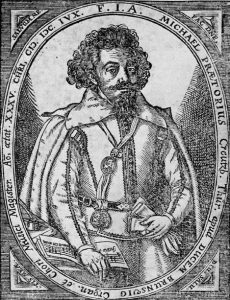By Donato Cabrera│medium.com/@donatocabrera
December 10, 2020

Michael Praetorius
The German composer, Michael Praetorius, is an incredibly important figure in the understanding and development of 17th century music. Not only because of the voluminous amount of music that he composed over the course of his forty-nine years, but because of the three volume treatise, Syntagma Musicum, that he wrote about music and music-making between 1614–1620. In fact, these three books were one of the most important documents that helped scholars and musicians with the early music revival in the 20th century.
Praetorius was born Michael Schultze in 1571 in Creuzburg, which is smack dab in the middle of Germany, to a Lutheran pastor. He would eventually take the Latinate version of his name Schultze means magistrate and Praetorius is the Latin word for magistrate. He studied divinity and philosophy at the University of Frankfurt an der Oder (the ‘other’ Frankfurt near the Polish border). From 1592 until almost his in 1621, he served at the Brunswick-Lüneburg court in Wolfenbüttel, beginning as organist and eventually becoming Kapellmeister (music director).
Praetorius’ music, however, would be heavily influenced by the music that was being composed in Italy, particularly in Venice. The Venetian composer, Giovanni Gabrieli, was writing polychoral works that Praetorius emulated in his music. The term, polychoral, simply meant that the music was written in a way to have many small choirs placed throughout the church, which created a surround-sound effect for the listener. Here’s an example.
In 1609, Praetorius harmonized the already popular Christmas hymn, Es ist ein Ros’ entsprungen, commonly translated into English, Lo, how a rose e’er blooming, but the literal translation is A rose has sprung up. The rose has always been a symbol for the Virgin Mary and the hymn also makes references to the prophecies of Isaiah. It is an anonymous text thought to have been written in the 15th century and Martin Luther is believed to have used it.
Es ist ein Ros’ entsprungen
Aus einer Wurzel zart,
Als uns die Alten sungen,
Von Jesse kam die Art
Und hat ein Blümlein bracht
Mitten im kalten Winter,
Wohl zu der halben Nacht.Das Röslein, das ich meine,
Davon Jesaias sagt,
Hat uns gebracht alleine
Marie, die reine Magd.
Aus Gottes ew’gem Rat
Hat sie ein Kind geboren
Welches uns selig macht.O Jesu, bis zum Scheiden
Aus diesem Jammertal
Laß dein Hilf uns geleiten
Hin in den Freudensaal,
In deines Vaters Reich,
Da wir dich ewig loben,
O Gott, uns das verleih.A rose has grown
from a tender root,
just as the ancients foretold.
It stemmed from Jesse
and brought forth a flower
in the depth of winter,
at dead of night.The rose I have in mind,
of which Isaiah speaks,
has been given to us by Mary alone,
the chaste maiden.
By God’s eternal counsel
she has borne a child
that makes us blessed.O Jesus, till the hour of our parting
from this vale of sorrow
help us, guide us
to paradise
in your Father’s kingdom,
for we forever praise you;
grant us this, O God.
It is a simple melody that gently rises at first, emulating the slow and mysterious blooming of a rose, but the melody then just as gently heads downward, revealing the ‘tender root’ of the flower. I am annually beguiled by this carol, this Marian hymn, and for me there no other performance exists than this, performed by The Gesualdo Six, in the beautiful Ely Cathedral.
